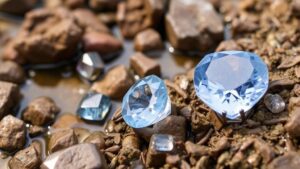Rainbow Fossils: Opalescent Ammonites and Their Stunning Natural Transformation
Rainbow Fossils: Opalescent Ammonites and Their Stunning Natural Transformation
Ammonites, the spiral-shaped marine creatures that roamed the Earth more than 65 million years ago, have captivated the interest of rockhounds and mineral collectors around the world. Among these ancient fossils, opalescent ammonites stand out for their breathtaking iridescence–a vibrant display of colors reminiscent of a rainbow. This article delves into the fascinating transformation of these fossils, their unique properties, and essential information for collectors.
The Science Behind Opalescence
The opalescent quality of ammonite fossils is primarily due to a natural process called iridescence. When the shell of an ammonite undergoes mineralization, it often incorporates minerals such as aragonite and calcite. Over millions of years, these materials are replaced by silica, specifically in the form of opal. The structure of opal allows for the refraction of light, which produces the vibrant colors seen in these fossils.
Scientific studies indicate that the opalescence in ammonites occurs due to a photonic crystal structure within the fossilized material. This structure creates a diffraction effect that results in the rainbow-like appearance. The discovery of these fossils often takes place in sedimentary rock formations, with notable finds in regions such as Madagascar, Canada, and parts of the United States.
Identifying Opalescent Ammonites
For collectors, identifying opalescent ammonites is crucial. Here are some features to consider:
- Coloration: Look for vibrant colors, often exhibiting blue, green, and red hues.
- Pattern: Examine the shell structure for the characteristic spiral shape and intricate suture lines.
- Texture: Feel the surface; well-preserved fossils may appear smooth, while others might be more textured due to erosion.
Understanding these identifiers can greatly enhance a collectors ability to discern high-quality specimens from less desirable ones.
Real-World Applications and Uses
Opalescent ammonites are not just fascinating collectibles; they also have applications in various industries. Here are a few examples:
- Jewelry Making: Many artisans incorporate opalescent ammonites into jewelry, creating unique pieces that combine ancient history with modern design.
- Education: These fossils serve as a valuable resource in geological and paleontological studies, highlighting the history of life on Earth.
- Display and Decor: Opalescent ammonites make stunning display pieces in museums and private collections, attracting interest from both enthusiasts and the general public.
Tips for Collectors
For those looking to add opalescent ammonites to their collections, consider the following tips:
- Research Locations: Certain areas are known for their high-quality ammonite fossils. Focus on locations like the Bearpaw Formation in Canada or the sedimentary deposits in Madagascar.
- Attend Fossil Shows: Participate in fossil expos or mineral shows where you can meet other collectors and vendors, giving you access to rare finds.
- Check Authenticity: Ensure that your specimens are genuine. Acquisition from reputable dealers is essential, and consider having your fossils appraised by experts.
Conclusion
Rainbow fossils, especially opalescent ammonites, are a stunning testament to natures artistry and the passage of time. r intricate structures and captivating colors not only inspire wonder but also offer intriguing insights into the Earths geological and biological history. By understanding the science behind their formation, recognizing their unique traits, and applying practical tips for collection, enthusiasts can cultivate a treasure trove of these beautiful remnants from the past. Engaging with the fossil community can enhance the journey, bringing fellow collectors together in a shared passion for these extraordinary specimens.



